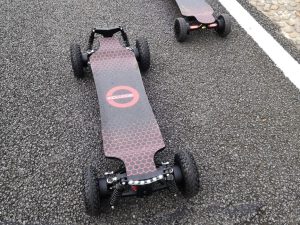Electric skateboard have emerged in recent years as a sustainable transportation choice for environmentally conscious riders. As compact electric vehicles, e-skateboards provide emissions-free personal mobility for short trips. They present minimal environmental impact compared to gas-powered automobiles in several key ways:

Zero Emissions: A Breath of Fresh Air
The most compelling eco-friendly advantage of electric skateboards is their zero-emission operation. Unlike traditional vehicles powered by internal combustion engines, which burn fossil fuels like gasoline or diesel, e-skateboards run on the power stored in rechargeable lithium-ion battery packs and are driven by electric motors. This effectively eliminates direct emissions associated with their operation, making e-skateboarding a carbon-neutral mode of transportation.
While many forms of transportation contribute to greenhouse gas emissions – for instance, cars, trucks, buses, trains, and even some forms of renewable energy – electric skateboards stand out due to their ability to operate without producing harmful gases. According to the Environmental Protection Agency (EPA), transportation accounts for around 29% of total U.S. greenhouse gas emissions, a significant portion of which comes from personal vehicles.
Electric skateboards, therefore, offer an incredible opportunity to decrease these emissions. By choosing to ride an electric skateboard for short trips around town instead of driving a car, each rider can significantly reduce their transportation-related emissions. As minor as it might seem, if just one person replaces multiple short car trips each week with an electric skateboard, over time, this has a noticeable impact.
Furthermore, if electric skateboard became more mainstream and were widely adopted by individuals for daily commuting or short errands, the cumulative effect would considerably mitigate transportation-related carbon emissions. This large-scale adoption could be a game-changer, offering a real, practical solution to one of the leading causes of climate change.

Less Congestion: Making Way for Smoother Urban Mobility
Another significant advantage of electric skateboards lies in their ability to alleviate traffic congestion, particularly in dense urban environments. Unlike traditional vehicles, these boards have a slim profile that occupies just a fraction of the space on roads and sidewalks, comparable more to cyclists than to large SUVs or sedans.
Electric skateboards are typically ridden in bike lanes or along the shoulder of roads, further reducing their footprint on main roadways. This not only enables riders to navigate busy streets more easily but also promotes smoother traffic flow by preventing additional congestion. Just imagine if more city residents replaced their typical 2-3 mile car trips with an e-skateboard; it would result in fewer vehicles clogging up city streets, allowing for more efficient movement for everyone.
Reducing traffic congestion through electric skateboarding has knock-on environmental benefits as well. Less congestion implies less time spent idling in traffic, which in turn minimizes vehicle emissions produced during these idle periods. Given that idling engines contribute significantly to air pollution, this reduction can lead to improved air quality in urban areas.
Moreover, another often overlooked aspect of congestion is the need for parking spaces. Traditional vehicles require substantial space not only on the road but also when they’re at rest. Large parking lots and multi-story garages consume valuable urban real estate that could be put to more sustainable uses.
By contrast, the compact size of motorized boards drastically reduces the necessity for expansive parking infrastructure. Think about all the space currently dedicated to parking in cities. Now, imagine reclaiming much of that space because an increasing number of people have started using e-skateboards instead of cars for short journeys.
This freed-up space could then be repurposed into parks, wider sidewalks, and bike lanes, promoting greener, healthier cities. It could also be used for other community enrichments like outdoor recreational facilities or even residential zones, contributing to a more vibrant and livable urban environment.

Reduced Noise Pollution: A Quieter Ride for a Quieter City
Motorized boards lend themselves to a more peaceful urban soundscape, largely due to the quiet operation of their electric motors and wheel design. Unlike the loud revving of combustion engines in traditional cars and motorbikes, e-skateboards generate minimal noise pollution.
The primary source of sound in an e-skateboard comes from its hub motor, which has just one moving part. This results in a buzzing or humming sound that is barely louder than a typical box fan. Compared to the roaring engines of road cars, the hum of an motorized board going down the street can be a pleasant change.
In cities often plagued by persistent traffic noise, this could mean a significant reduction in overall sound pollution. If short car trips were replaced with near-silent electric skateboarding journeys, the cumulative effect on city noise levels would be substantial. This would lead to quieter, more livable urban environments, improving residents’ quality of life by reducing noise-related stress and disturbance.
Clean Energy Power Source: Harnessing Renewable Resources
Charging an electric skateboard’s battery utilizes electricity from the power grid. This contrasts sharply with traditional vehicles, which are fueled by gasoline derived from crude oil. As our power grids increasingly draw from renewable energy sources like solar, wind, and hydropower, electric skateboards essentially run on cleaner energy. When compared to conventional gas engines, motorized boards open up access to transportation powered by renewable electricity generation, reflecting a sustainable shift in our approach to personal mobility.

Minimal Maintenance: Less Is More
One of the underappreciated benefits of electric skateboards is their minimal maintenance requirements. Traditional vehicles with internal combustion engines have numerous mechanical parts that require regular care — oil changes, engine tune-ups, muffler, and transmission repairs, to name a few.
However, electric skateboards sidestep most of these routine maintenance needs. With far fewer mechanical parts and an electric motor that has just one moving component, e-skateboards are simpler and less resource-intensive to maintain.
This reduced need for upkeep implies less waste over time, both in terms of physical materials (like oil and replacement parts) and the associated environmental impact of producing and disposing of these materials. Thus, by requiring less maintenance, e-skateboards again prove their worth as a low-impact transportation solution that aligns with a more sustainable future.
Conclusion
In summary, electric skateboards enable individuals to shrink their transportation footprint for local trips. As e-skateboard adoption grows, cities can reduce emissions, noise, congestion, and pollution while providing residents with clean, sustainable mobility options. The eco-friendly attributes make motorized boards an excellent travel choice for environmentally conscious individuals.
Read More
- Are Electric Skateboards Dangerous – Ecomobl
- Off Road Electric Skateboards Safety – Ecomobl
- Off Road Electric Skateboards Vs Mountain Bikes – Ecomobl
- Electric Skateboarding Fitness – Ecomobl
- Off Road Electric Skateboard Top Features – Ecomobl




